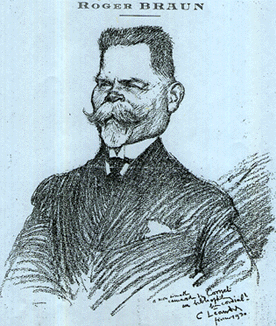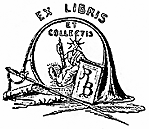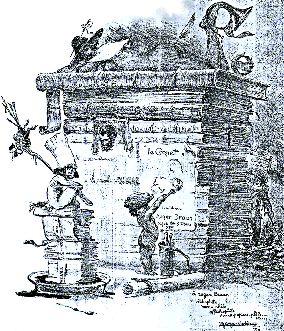(1862-1941)
Extracts
from the discussion made to the diner of the "Vieux Papier", the
18th novembre 1998.
Delphine Lallement, "Roger Braun (1862-1941), collectionneur et vice-président
du Vieux Papier", Bulletin de la Société Archéologique, Historique
et artistique Le Vieux Papier,
Fascicule 352, Tome XXXV, Avril 1999, pp.241-247.
|
Illustrated
menus and posters collector
|
||
|
I
would like to introduce you an unknown collector form a large public,
which lived in Paris at the end of the XIXth century and the beginning
of the XXth.
He was the subject of my master's. |
||
|
|
||
|
Biography Roger Théodore Edouard Braun (1862 Ville d'Avray - 1941 Paris). He came from an Alsatian and Protestant family. He was married and had a girl. His sister was married with the well-known Etienne Moreau-Nélaton, a famous collector. He studied law and he was notary during thirty years at Saint-Maur-des-Fossés. But he was always attracted by the world of art. From 1883 to 1885, at the age of twenty-one, he worked as journalist, editor and than as head-editor at the dailynews "L'Orchestre", which offered theatre and music play-bill. He adhered to the delirious movement of art, called the "Incohérents". |
||
|
Collections We could say that he was a "collector of collections". He made plenty of collections : illustrated menus and play-bills, engraving, print, French and foreign posters, rare books, albums of artists, satirical revues, address-cards, invitations, catalogues. His residence in Alsace was also full of porcelains, paintings and art household furnitures. |
||
 Roger Braun by Charles Léandre |
||
|
|
||
|
Societies and artists friends He met a lot of famous artists, like Charles Léandre, Adolphe Willette, Georges Villa and Maurice Neumont. He was an active man and invested himself in about twenty cultural societies, as the historical and archaeological society of the 1st and 2nd district Le Centre de Paris, the Vieux Papier Society (in which he was the vice-president), Le Vieux Montmartre (he was also the vice-president), Le Cornet and he created the society Les Bibliophiles du Cornet. At that period, bourgeois people, as notary, and artists often jointed there knowledge and humour around a good diner, without women. |
||
 |
||
|
Bookplate As a bibliophile, he had a bookplate done. This propriety mark shows his fashion, ideas and profession. The musical instrument, the cornet, reminds his participation in the alpine hunter company, and the sword his officer rank. The woman representing the Republic indicates his profession : notary. The piled up books underlines his passion for rare books. His initials "R.B." are written in down. The feather represents his interest in literature and art. This bookplate sums up all passions of this collector, amateur of arts. |
||
|
|
||
|
His collections of menus and posters - The menus The collection of menus was the biggest : he owned about 16.000 and 20.000 menus. The topics of these menus are military, emanating from the government, private, personal, poetic, artistic, in majority from society, history and gastronomy. He was so proud of his collection, that in his testament, he wrote about his collection that it was "unique in the world", which is quite true. He collected menus and also became a commander. When he was the president of the Cornet society, he asked his friend Georges Villa to do a menu for the diner. As the bookplate, we find books, the cornet, but also a lot of menus in a plate representing his menus collection. A young child hang a poster on which we can see his profile portrait. Behind the wall of books, another boy picks up some old papers on the floor, this rag-picker symbolises the other society Vieux Papier. He commanded a menu to his friend Maurice Neumont to do homage to his dead artist friend Adolphe Willette. |
||
| - The posters His second big collection was made of French and foreign posters. He owned more than one thousand posters, with famous names as Chéret (he had one hundred), Mucha, Steinlen (thirty-two), Grasset (eighten) and very famous trade-marks and subjects as the cigarette's paper Job, the big exposition the Salon des Cent, the musical artist as Loïe Fuller and also Sarah Bernardt. |
||
|
To conclude I would say that this "collector of arts" has created his own art with his collection. He lived with arts and by his implication in the world of art we could say that he was an "aesthete", as many's people in the XIXth century. During his life, he was a generous man and he was still going on after his death with his collections, because he donated them to French museums. |
